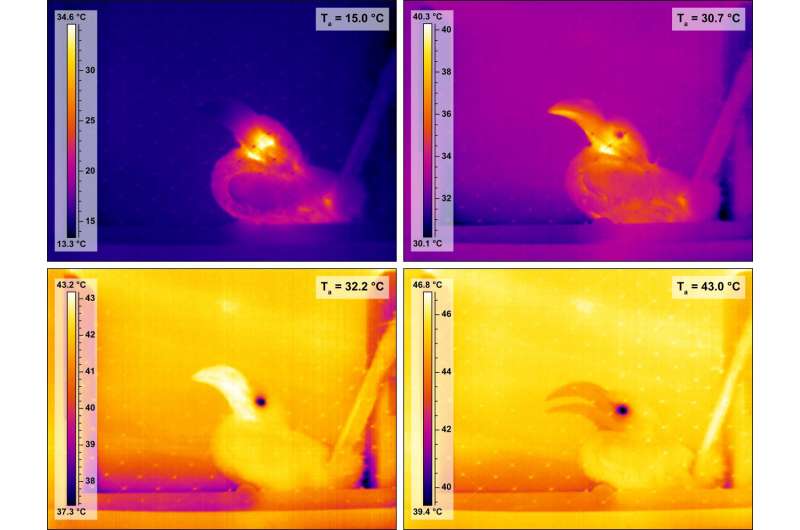Hornbills in the Kalahari desert may keep cool by losing heat through their beaks

When temperatures are scorching, southern yellow-billed hornbills in the Kalahari Desert of southern Africa dilate blood vessels in their beaks to thermoregulate and cool off, according to a study published May 18, 2016 in the open-access journal PLOS ONE by Tanja van de Ven from the Percy FitzPatrick Institute of African Ornithology, University of Cape Town, South Africa, and colleagues.
While mammals have sweat glands to keep their bodies from overheating, birds may rely on panting (evaporative heat loss) and dilating their blood vessels (non-evaporative heat loss), particularly in their beaks. Toco Toucans are an example of the latter: their outsized beaks account for up to 60% of their non-evaporative heat loss at air temperatures above 28 degrees Celsius. Although not as extreme as toucan beaks, hornbill beaks are still quite large relative to their bodies. To determine whether hornbills might likewise use their beaks for this purpose, the authors of this study raised the air temperature around 18 wild-caught southern yellow-billed hornbills and tracked their heat loss with thermal imaging.
The researchers found that the beaks accounted for up to 20% of the birds' non-evaporative heat loss, and suggest that the benefits of heat loss from beaks on hot days likely varies according to where the birds live. In tropical forests where toucans typically live, for example, beak heat loss could be key, as humidity may make panting less effective. For those southern yellow-billed hornbills living in the desert, beak heat loss could be important as, in contrast to panting, it may help to conserve scarce water.
Tanja van de Ven notes: "We have found that, like toucans, hornbills can use their beak as a controllable thermal radiator. We think this might provide an advantage in the arid Kalahari by reducing the amount of water the birds need to spend on evaporative cooling".

More information: T. M. F. N. van de Ven et al, Regulation of Heat Exchange across the Hornbill Beak: Functional Similarities with Toucans?, PLOS ONE (2016). DOI: 10.1371/journal.pone.0154768
Journal information: PLoS ONE
Provided by Public Library of Science



















